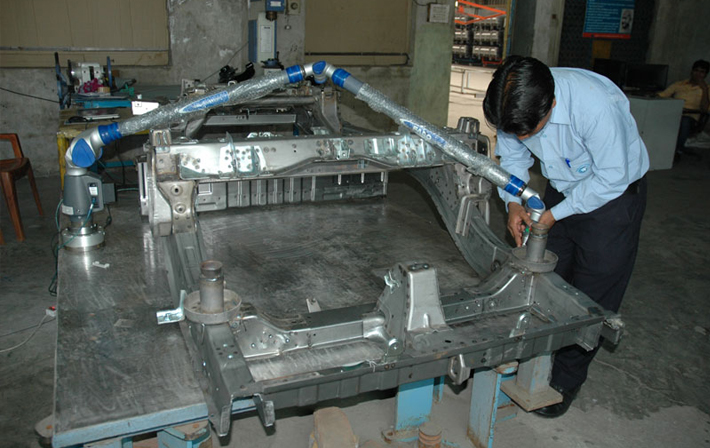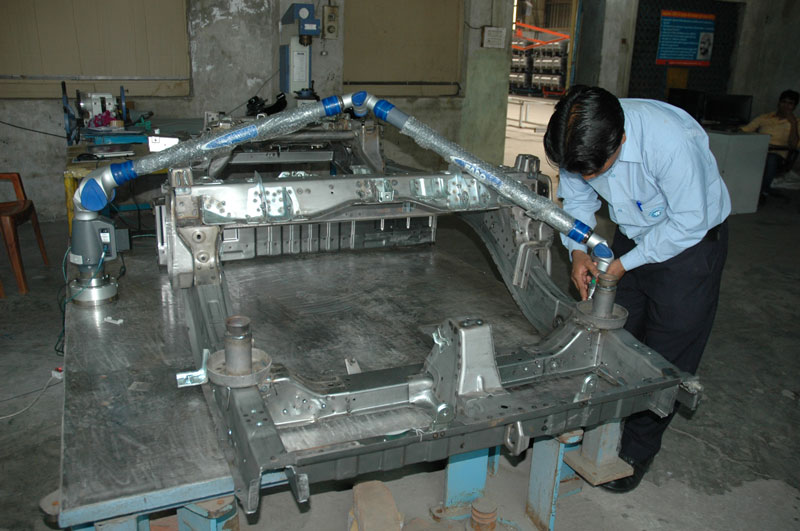For Good Measure

Predominantly used to assess manufacturing quality, two-dimensional (2D) tools such as vernier calipers or micrometers were widely employed across industries before the development of more advanced solutions such
as three-dimensional (3D) measurement devices. Compared to 3D tools, 2D versions are more time consuming to operate, less capable of measuring large objects, and typically do not have the means to capture and store measurement data digitally. In recent decades, as awareness for 3D measurement systems has increased, more and more companies are beginning to adopt advanced metrology devices as they recognize the tremendous benefits of utilizing such tools over traditional 2D types.
Anusaya, the company
A long-time user of 2D tools, Anusaya Auto Press Parts Pvt Ltd had been tackling measurement challenges since it started business in 1996. A subsidiary of the Wadhokar Group, it was first founded as a major supplier to Tata Motors starting its presence in Maharashtra. Since then, Anusaya’s portfolio has expanded to include notable organizations, including Fiat India, LG Electronics India, and Philips India.
The company’s main competence lies in the forming of sheet metals but it also has expertise in handling sub-assemblies and automotive frames. As the company grew, its operational focus became increasingly divided between supplying for the auto-ancillary as a major industry and the consumer durables industries - both of which require fast and precise measurement results.

FaroArm Provides Auto Parts Maker with 3D Measurement Capabilities.
Need for a catalyst
-e.jpg) “We had been using 2D measurement tools since the beginning, and it was challenging at times when product order deliveries never seemed to end. Project completions took a longer time because the tools slowed us down, and sometimes we even had to manually move objects before we were able to measure them. We believe that a catalyst was needed to encourage any change from taking place,” shared Umesh C Ahuja, Plant Head, Anusaya.
“We had been using 2D measurement tools since the beginning, and it was challenging at times when product order deliveries never seemed to end. Project completions took a longer time because the tools slowed us down, and sometimes we even had to manually move objects before we were able to measure them. We believe that a catalyst was needed to encourage any change from taking place,” shared Umesh C Ahuja, Plant Head, Anusaya.
The external push
The catalyst that pushed Anusaya to adopt more advanced measurement equipment came in the most unlikely of forms. “One of our major customers was actually the motivating factor behind this change,” explained Ahuja. “As experienced users of 3D measurement systems, they had so many positive things to say about the equipment – so much so that they suggested we invest in a portable 3D measurement device as well. The team was intrigued and we knew that we needed to enhance our productivity.”
“Coming from using 2D tools, Anusaya has achieved countless benefits with Faro, such as time savings, reduction in using manual labor, ability to measure different component parts, capturing and storing digital data, and even to using CAD data to replace 2D drawings.”
Umesh C Ahuja,
Plant Head,
Anusaya Auto Press Parts Pvt Ltd
Widely known to increase measurement accuracy levels, 3D measurement devices also have a good reputation in increasing efficiency, reducing the amount of time needed for taking measurements, and capturing measurement digital data easily.
“When word got out in the market that we were looking to purchase 3D metrology equipment, we were instantly presented with an array of options from several 3D measurement providers,” added Ahuja.
Anusaya’s Choice: the FaroArm Fusion
Once notified that Anusaya was on the lookout for a 3D measuring equipment, Faro was confident that its 3D coordinate measuring machine (CMM) could help Anusaya with its measurement challenges, recalled Sushil Arya, Regional Sales Manager (North India), Faro.
“After assessing Anusaya’s needs, Faro brought in the FaroArm Fusion for a demon-stration, and right away there was immediate acceptance of the device,” he added.
With the reputation of being a comprehensive portable tool for performing inspections, tool certification, and reverse engineering and used across the automotive, metal fabrication, molding, and aerospace indus-tries, the Fusion was able to meet Anusaya’s measurement needs for alignment, calibration, inspection, dimensional calculations, quality control, and free-form component inspection.
Pleased with what they witnessed during the demonstration, Anusaya made their first portable CMM purchase in 2012. “The biggest surprise was that the Fusion was not just limited to application during assemblies, but that it was also capable of measuring any manufactured component,” informed Ahuja.
A fusion of benefits
Capable of a wide measurement range, the 12-feet Fusion features an extended-use battery, and infinite rotation for non-stop measuring. Operators no longer need to transport objects to a measurement device, they simply did the reverse instead. With the Fusion, productivity at Anusaya has increased due to the time savings achieved.
“Although we witnessed its ability to achieve time savings during the demonstration, we were still pleasantly surprised when we carried out our first task with the device during first article inspection. In all our years of using 2D tools, we never imagined that we could save up to 85 percent in total measurement time. A significant presence within our operations, the Fusion is fully utilized every day from first article inspection, all the way to post production,” said Ahuja.
Perhaps out of the many derived benefits, computer-aided design (CAD) and digital data are the two that are most valued by Anusaya. The Fusion is able to utilize CAD data from initial design through to the finishing stages. 2D drawings can now be replaced by taking measurement points from any 3D component instead. Additionally, the device is also able to capture and store digital data.
Source: Faro Business Technologies India Pvt Ltd



 Facebook
Facebook.png) Twitter
Twitter Linkedin
Linkedin Subscribe
Subscribe